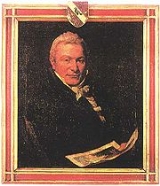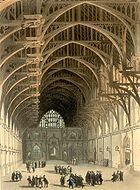
Augustus Charles Pugin
Encyclopedia
Augustus Charles Pugin, born Auguste Charles Pugin, (1762–1832) was an Anglo-French artist, architectural draughtsman
, and writer on medieval architecture
. He was born in Paris
, France
, but his father was Swiss, and Pugin himself was to spend most of his life in England
.
Pugin left France during the Revolutionary
period for unclear reasons and entered the Royal Academy
Schools in London in 1792. Shortly afterwards he obtained a position as an architectural draughtsman with the architect John Nash
. After considering and abandoning a career in architecture Pugin married and settled on a career as a commercial artist working primarily for publishers of illustrated books. He was a skilful watercolourist as well as an accomplished draftsman.
, Oxford and Cambridge
universities and Winchester College
. He often collaborated with other artists, notably Thomas Rowlandson
. His later works included illustrations for Specimens of Gothic Architecture (1821-23), The Royal Pavilion at Brighton (1826), Architectural Antiquities of Great Britain (1826), Specimens of the Architectural Antiquities of Normandy (1827), Illustrations of the Public Buildings of London (1825 to 1828), and Paris and its Environs (1829 to 1831), and Examples of Gothic Architecture (1831). He also produced a book of furniture designs called Gothic Furniture, and assisted architects with detailing for their gothic designs. He ran a drawing school at his house in Great Russell Street, Bloomsbury
.
Pugin, along with J. Morgan, also designed the Diorama
building in Regents Park in 1823, to house and display the Dioramas of Louis Jacques Mandé Daguerre (1787–1851), a year after the debut of his Paris original in 1822. These exhibitions in London displayed eight of the Daguerre Dioramas (1823-1832), which were also exhibited on tour in Liverpool, Manchester, Dublin and Edinburgh (1825-1836).
Pugin's developing interest in the Gothic was to be magnified in the career of his son Augustus Welby Pugin, an architect who was the leading advocate of Gothicism in 19th century England. His son also sometimes assisted him in some of his publications.
Draughtsman
A draughtsman or draftsman , is a person skilled in drawing, either:*drawing for artistic purposes, or*technical drawing for practical purposes such as architecture or engineering...
, and writer on medieval architecture
Medieval architecture
Medieval architecture is a term used to represent various forms of architecture common in Medieval Europe.-Characteristics:-Religious architecture:...
. He was born in Paris
Paris
Paris is the capital and largest city in France, situated on the river Seine, in northern France, at the heart of the Île-de-France region...
, France
France
The French Republic , The French Republic , The French Republic , (commonly known as France , is a unitary semi-presidential republic in Western Europe with several overseas territories and islands located on other continents and in the Indian, Pacific, and Atlantic oceans. Metropolitan France...
, but his father was Swiss, and Pugin himself was to spend most of his life in England
England
England is a country that is part of the United Kingdom. It shares land borders with Scotland to the north and Wales to the west; the Irish Sea is to the north west, the Celtic Sea to the south west, with the North Sea to the east and the English Channel to the south separating it from continental...
.
Pugin left France during the Revolutionary
French Revolution
The French Revolution , sometimes distinguished as the 'Great French Revolution' , was a period of radical social and political upheaval in France and Europe. The absolute monarchy that had ruled France for centuries collapsed in three years...
period for unclear reasons and entered the Royal Academy
Royal Academy
The Royal Academy of Arts is an art institution based in Burlington House on Piccadilly, London. The Royal Academy of Arts has a unique position in being an independent, privately funded institution led by eminent artists and architects whose purpose is to promote the creation, enjoyment and...
Schools in London in 1792. Shortly afterwards he obtained a position as an architectural draughtsman with the architect John Nash
John Nash
John Nash may refer to:*John Nash , Anglo-Welsh architect*John Forbes Nash, Jr. , American mathematician, 1994 Nobel Economics laureate, subject of the book and film titled A Beautiful Mind...
. After considering and abandoning a career in architecture Pugin married and settled on a career as a commercial artist working primarily for publishers of illustrated books. He was a skilful watercolourist as well as an accomplished draftsman.
Drawings
Pugin produced views of London, and plates for books about Westminster AbbeyWestminster Abbey
The Collegiate Church of St Peter at Westminster, popularly known as Westminster Abbey, is a large, mainly Gothic church, in the City of Westminster, London, United Kingdom, located just to the west of the Palace of Westminster. It is the traditional place of coronation and burial site for English,...
, Oxford and Cambridge
University of Cambridge
The University of Cambridge is a public research university located in Cambridge, United Kingdom. It is the second-oldest university in both the United Kingdom and the English-speaking world , and the seventh-oldest globally...
universities and Winchester College
Winchester College
Winchester College is an independent school for boys in the British public school tradition, situated in Winchester, Hampshire, the former capital of England. It has existed in its present location for over 600 years and claims the longest unbroken history of any school in England...
. He often collaborated with other artists, notably Thomas Rowlandson
Thomas Rowlandson
Thomas Rowlandson was an English artist and caricaturist.- Biography :Rowlandson was born in Old Jewry, in the City of London. He was the son of a tradesman or city merchant. On leaving school he became a student at the Royal Academy...
. His later works included illustrations for Specimens of Gothic Architecture (1821-23), The Royal Pavilion at Brighton (1826), Architectural Antiquities of Great Britain (1826), Specimens of the Architectural Antiquities of Normandy (1827), Illustrations of the Public Buildings of London (1825 to 1828), and Paris and its Environs (1829 to 1831), and Examples of Gothic Architecture (1831). He also produced a book of furniture designs called Gothic Furniture, and assisted architects with detailing for their gothic designs. He ran a drawing school at his house in Great Russell Street, Bloomsbury
Bloomsbury
-Places:* Bloomsbury is an area in central London.* Bloomsbury , related local government unit* Bloomsbury, New Jersey, New Jersey, USA* Bloomsbury , listed on the NRHP in Maryland...
.
Pugin, along with J. Morgan, also designed the Diorama
Diorama
The word diorama can either refer to a nineteenth century mobile theatre device, or, in modern usage, a three-dimensional full-size or miniature model, sometimes enclosed in a glass showcase for a museum...
building in Regents Park in 1823, to house and display the Dioramas of Louis Jacques Mandé Daguerre (1787–1851), a year after the debut of his Paris original in 1822. These exhibitions in London displayed eight of the Daguerre Dioramas (1823-1832), which were also exhibited on tour in Liverpool, Manchester, Dublin and Edinburgh (1825-1836).
Pugin's developing interest in the Gothic was to be magnified in the career of his son Augustus Welby Pugin, an architect who was the leading advocate of Gothicism in 19th century England. His son also sometimes assisted him in some of his publications.
 |

